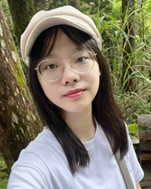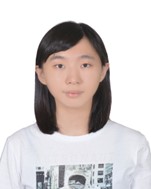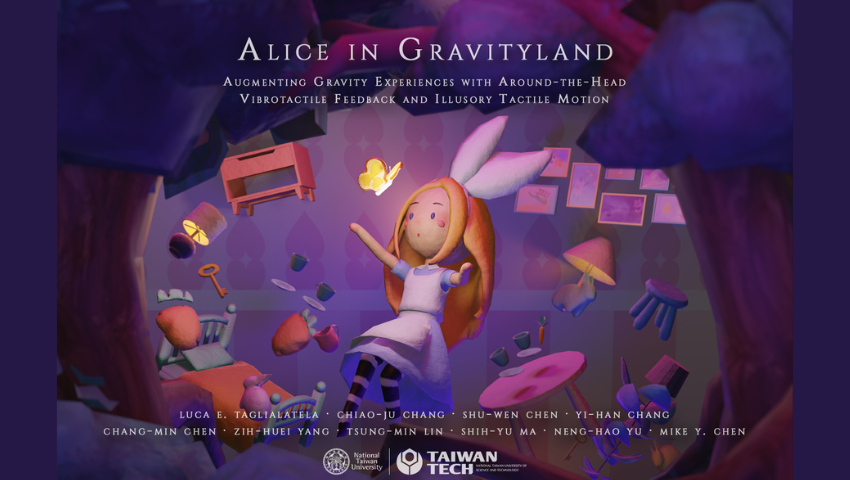Image by Yi-Han Chang.
Off with their VR head(set)s! If you are getting “curiouser and curiouser” about the world of VR, then look no further. SIGGRAPH sat down with the creators behind the SIGGRAPH 2023 Immersive Pavilion selection, “Alice in Gravityland: Augmenting Gravity Experiences With Around-the-head Vibrotactile Feedback and Illusory Tactile Motion,” at the Mad Hatter’s Tea Party to learn more about their inspiration behind this immersive experience, the tools used to create their project, and what they hope participants take away from the experience this August in Los Angeles.
SIGGRAPH: Tell us about the process of developing “Alice in Gravityland: Augmenting Gravity Experiences With Around-the-head Vibrotactile Feedback and Illusory Tactile Motion.” What inspired you to pursue the project?
Mike Y. Chen (MC): Our journey began in a rather unassuming setting: a university classroom. This was part of a broader initiative — led by Professor Jones Yu and myself — aiming to stimulate cross-disciplinary collaboration between engineering and design students, transcending departmental and even university boundaries. The inspiration for the project sprang from our shared enthusiasm for pushing the boundaries of cutting-edge VR and haptic technologies to create immersive and out-of-this-world experiences. Inspired by the gravity-defying experiences in movies such as “Inception” (2010) and “Interstellar” (2014), we challenged ourselves to deliver a variety of virtual gravity experiences through a whimsical puzzle game based on a classic, wonder-filled narrative that everyone is instantly familiar with, “Alice in Wonderland.”
SIGGRAPH: What was your favorite aspect of creating this project?
Luca E. Taglialatela (LT): One of our favorite aspects of this project was the joint collaboration across our affiliated institutes. We had both developers building the interactive experience and designers creating the 3D models and textures. This division of expertise played a significant role in our productivity as well as how we set the bar for ourselves. Seeing the project finally come together was a very rewarding experience for all of us, as our combined effort and shared enthusiasm resulted in something beyond what we could have achieved individually.
SIGGRAPH: What specific challenges came about during the making of this VR experience?
LT: We encountered several challenges along the way since most of us were relatively new to VR development. We had to acquire the necessary skills and knowledge as we progressed with the project. Plus, a lot of time went into polishing the interaction and haptic feedback. The hand tracking-based mechanics, in particular, required a lot of fine-tuning until they were sufficiently smooth and responsive to interact with. There was also the challenge of designing vibrotactile patterns that complemented the gravity experiences, while at the same time being perceptually distinct from one another. But despite these challenges, we persevered and are incredibly proud of the VR experience that we have been able to create.
SIGGRAPH: What made you decide to tell this timeless tale through the VR? Why is VR an appropriate medium for a story like “Alice in Wonderland”?
LT: The story of “Alice in Wonderland” is analogous to experiencing VR. When Alice tumbles down the rabbit hole, she is transported to a completely new world — much like putting on a VR headset and entering a wonderland of your own where your wildest dreams are possible. Drawing inspiration from the original story, we designed puzzles that needed to be solved by changing the player’s size and reversing time. Defying gravity is a surreal experience only possible through VR and a natural extension of the “Alice in Wonderland” universe — where the extraordinary is ordinary.
SIGGRAPH: What do you hope participants take away from their experience as they interact with your project at SIGGRAPH 2023?
MC: We hope that participants will experience gravity in ways that have only been depicted in movies like “Inception” (2010) and “Interstellar” (2014) and are otherwise impossible in real life. The illusory tactile motion haptic experience offered by the wearable headset is a novel sensation that most participants will be experiencing for the first time. We hope that it will inspire people to imagine and build innovative haptic feedback for experiences beyond our everyday reality.
SIGGRAPH: Do you have any advice for those looking to submit to Immersive Pavilion in the future?
MC: Collaborate with people with different backgrounds, including art, storytelling, engineering, gaming, and interaction design. Challenge your assumptions of what’s possible. Work on something you’re excited about and enjoy the journey of exploring new concepts while pushing boundaries!
Innovation and creativity awaits you in Los Angeles, 6-10 August. If you are looking to experience next-level advancements in AR, MR, and VR — just like “Alice in Gravityland” — then register for SIGGRAPH 2023 today.

Luca E. Taglialatela is currently finishing his master’s degree in computer science and information engineering at National Taiwan University, where he is a member of the Human-Computer Interaction Lab. After completing his bachelor’s degree in computer science at the Vrije Universiteit in Amsterdam, he sought to challenge himself by studying abroad. He is passionate about expanding his knowledge and learning new skills and is particularly interested in software and web development.

Chiao-Ju Chang is currently pursuing a master’s degree in computer science at National Taiwan University. She has a strong passion for game development, virtual reality (VR), and augmented reality (AR). Her expertise lies in creating engaging experiences through the implementation of particle systems. She is constantly driven to explore and delve deeper into these areas to broaden her knowledge and skills. She is excited about the endless possibilities and challenges that lie ahead in the world of gaming and immersive technologies.

Shu-Wen Chen is pursuing a master’s degree in the Graduate Institute of Communication Engineering at National Taiwan University. She is interested in virtual reality and has previously developed a virtual reality escape room game. She is passionate about exploring the immersive and interactive experiences that virtual reality can offer.

Yi-Han Chang is pursuing a master’s degree in the department of design at the National Taiwan University of Science and Technology (NTUST). She is particularly enthusiastic about 3D modeling and graphic design. She has worked as the team’s 3D art designer while advancing her knowledge on interactions and immersion in virtual reality.

Chang-Min Chen, who holds a master’s degree in medical device and imaging from National Taiwan University, is passionate about the intersection of VR and the medical field. Joining a VR game development team, he sought to expand his knowledge and skills in VR techniques. Now, he applies his expertise to enhance the visualization of medical images and explores the potential of VR, machine learning, and algorithms to advance immersive experiences in radiology and beyond.

Zih-Huei Yang has a master’s degree in design from National Taiwan University of Science and Technology (NTUST). She has over 13 years of work experience in the design field including UI/UX design and graphic design.

Tsung-Min Lin is a former member of the Human-Computer Interaction Lab at National Taiwan University and now works as a software engineer. Aside from his job, he is passionate about video games and game design, and even participates in indie game development with his friends. He loves to discover creative ways to deliver a game experience of any kind.

Shih-Yu (Leo) Ma is a master’s student in design at Taiwan Tech under the guidance of Prof. Jones Yu. Currently, he is a visiting scholar in computer science at the University of Colorado, Boulder, working with Prof. Tom Yeh. Leo’s research focuses on mixed reality, tangible interaction, accessibility, chatbot, and neuroscience. He holds a bachelor’s degree in electrical engineering and industrial design from Taiwan Tech.

Prof. Neng-Hao (Jones) Yu received his Ph.D. degree in the Graduate Institute of Networking and Multimedia from National Taiwan University, Taipei, Taiwan, in 2011. He is an assistant professor with the Department of Design, National Taiwan University of Science and Technology (NTUST), Taipei, Taiwan. Before joining NTUST, he created and directed the Innovative User Interface Lab (IUILab) at the Department of Computer Science, National Chengchi University (NCCU), Taipei, Taiwan, since 2011. His research focuses on human-computer interaction, user experience design, and VR/AR. His works are presented in a wide range of international conferences such as ACM CHI, UIST, MobileHCI, and IEEE VR.

Prof. Mike (Yen-Yang) Chen founded the Human-Computer Interaction (HCI) Lab at National Taiwan University (NTU) and has received Best Paper and Best Talk awards and won game design competitions at premier ACM conferences such as CHI, UIST, and SIGGRAPH. He innovates at the intersection of HCI, AI, and VR/AR and is renowned for creating and open-sourcing AirRacket, the first racket for virtual sports capable of directional force feedback, and HeadBlaster, the first wearable VR motion simulator. He has a Ph.D. in computer science from UC Berkeley, with a management of technology (MOT) certificate from UC Berkeley’s Haas School of Business. Prior to NTU, he led mobile R&D at Intel Research and startup Ludic Labs.



